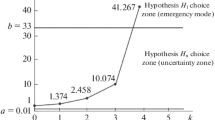Abstract
Information is presented on the current situation and prospects for integration of distributed generation (DG) and microgeneration facilities into distribution networks. The features of networks with DG objects are considered. The aspects that create significant difficulties for visual recognition and manual control of network modes are given. The necessity of creating automation systems for control of normal and emergency modes, which has the functions of recognizing the membership of the current mode in various mode areas, is substantiated. Also, the need to adapt algorithms and settings to the circuit-mode conditions is shown. It is shown that this problem should be solved at a fundamentally new scientific and technological level, using modern software and hardware systems that implement specialized control algorithms. The advantages of applying the Wald sequential procedure to recognize the current mode under conditions of decreasing frequency, transients, non-sinusoidality of currents and voltages, leading to large errors in the estimation of their parameters, are presented. It is proved that ensuring guaranteed high-speed performance of automatic control devices of modes is possible due to the introduction of a truncation algorithm for sequential analysis. An example of correct decision-making by a frequency unloading automation device in the “island mode” of operation of a distribution network with DG and microgeneration facilities based on the Wald procedure is given. This occurred in conditions of ambiguous frequency measurements and the presence of distorting factors. The authors’ recommendations on the application of the Wald sequential procedure for the implementation of relay protection and emergency automation devices in modes accompanied by complex transient processes are presented.
Access this chapter
Tax calculation will be finalised at checkout
Purchases are for personal use only
Similar content being viewed by others
References
Buchholz, B.M., Styczynski, Z.: Smart Grids – Fundamentals and Technologies in Electricity Networks. Springer, Heidelberg (2014)
Kakran, S., Chanana, S.: Smart operations of smart grids integrated with distributed generation: a review. Renew. Sustain. Energy Rev. 81(1), 524–535 (2018)
Ilyushin, P.V., Sukhanov, O.A.: The structure of emergency-management systems of distribution networks in large cities. Russ. Electr. Eng. 85(3), 133–137 (2014)
Ilyushin, P.V.: Analysis of the specifics of selecting relay protection and automatic (RPA) equipment in distributed networks with auxiliary low-power generating facilities. Power Technol. Eng. 51(6), 713–718 (2018)
Ilyushin, P.V., Kulikov, A.L., Filippov, S.P.: Adaptive algorithm for automated undervoltage protection of industrial power districts with distributed generation facilities. In: International Russian Automation Conference (RusAutoCon), pp. 1–6. IEEE, Sochi (2019)
Loskutov, A.A., Mitrovic, M., Pelevin, P.S.: Development of the logical part of the intellectual multi-parameter relay protection. In: Rudenko International Conference on Methodological Problems in Reliability Study of Large Energy Systems, RSES, vol. 139. EDP Sciences, Tashkent (2019)
Kulikov, A.L., Loskutov, A.A., Mitrovic, M.: Method of automated synthesis of the logic part of relay protection device which increases its sensitivity. In: IOP Conference Series: Materials Science and Engineering, vol. 643, p. 012124 (2019)
Ilyushin, P.V., Suslov, K.V.: Operation of automatic transfer switches in the networks with distributed generation. In: IEEE Milan PowerTech, pp. 1–6. IEEE, Milan (2019)
Ilyushin, P.V., Filippov, S.P.: Under-frequency load shedding strategies for power districts with distributed generation. In: International Conference on Industrial Engineering, Applications and Manufacturing, ICIEAM, pp. 1–5. IEEE, Sochi (2019)
Yurevich, Ye.N.: Theory of Automatic Control. Energiya, Leningrad, USSR (1975)
Sidorenko, Yu.A.: Theory of Automatic Control. BGATU, Minsk, Belarus (2007)
Yevsyukov, V.N.: Nonlinear automatic control systems: a textbook for university students. GOU OGU, Orenburg, Russia (2007)
Davarifar, M., Rabhi, A., Hajjaji, A., Daneshifar, Z.: Real-time diagnosis of PV system by using the sequential probability ratio test (SPRT). In: 16th International Power Electronics and Motion Control Conference and Exposition, pp. 508–513. IEEE, Antalya (2014)
Radio-electronic systems: Fundamentals of construction and theory, 2nd ed. Radiotekhnika, Moscow, Russia (2007)
Wald, A.: Sequential analysis. Fizmatlit, Moscow, USSR (1960)
Sharygin, M.V., Kulikov, A.L.: Protection and automation of power supply systems with active industrial consumers. NIU RANKhiGS, Nizhny Novgorod, Russia (2017)
Sharygin, M.V., Kulikov, A.L.: Statistical methods for recognizing modes in relay protection and automation of power supply networks. Elektricheskiye stantsii 2, 32–39 (2018)
Fukunaga, K.: Introduction to the statistical theory of pattern recognition. Nauka, Moscow, USSR (1979)
Fu, K.: Sequential methods in pattern recognition and machine learning. Nauka, Moscow, USSR (1971)
Shiryayev, A.N.: Statistical sequential analysis. Optimal stop rules. Nauka, Moscow, USSR (1976)
Basharinov, A.Ye., Fleyshman, B.S.: Statistical sequential analysis methods and their radio engineering applications. Sovetskoye radio, Moscow, USSR (1962)
Sochman, J., Matas, J.: Waldboost-learning for time constrained sequential detection. In: IEEE Computer Society Conference on Computer Vision and Pattern Recognition (CVPR 2005), vol. 2, pp. 150–156. IEEE, San Diego (2005)
Lorden, G.: Structure of sequential tests minimizing an expected sample size. Zeitschrift fur Wahrscheinlichkeits-theorie undverwandte gebiete 51(3), 291–302 (1980)
Ayvazyan, S.A.: Distinguishing close hypotheses about the form of distribution density in the scheme of a generalized sequential criterion. Theory of Probability and its Applications (1965)
Acknowledgement
The presented research results were obtained with the support of a grant from the President of the Russian Federation for state support of young Russian scientists (MK-3210.2019.8). Agreement No. 075-15-2019-337 of 11.06.2019.
Author information
Authors and Affiliations
Corresponding author
Editor information
Editors and Affiliations
Rights and permissions
Copyright information
© 2020 The Editor(s) (if applicable) and The Author(s), under exclusive license to Springer Nature Switzerland AG
About this paper
Cite this paper
Pavel, I., Aleksandr, K., Anton, L. (2020). Application of the Wald Sequential Procedure in Automatic Network Control with Distributed Generation. In: Silhavy, R., Silhavy, P., Prokopova, Z. (eds) Software Engineering Perspectives in Intelligent Systems. CoMeSySo 2020. Advances in Intelligent Systems and Computing, vol 1295. Springer, Cham. https://doi.org/10.1007/978-3-030-63319-6_11
Download citation
DOI: https://doi.org/10.1007/978-3-030-63319-6_11
Published:
Publisher Name: Springer, Cham
Print ISBN: 978-3-030-63318-9
Online ISBN: 978-3-030-63319-6
eBook Packages: Intelligent Technologies and RoboticsIntelligent Technologies and Robotics (R0)




